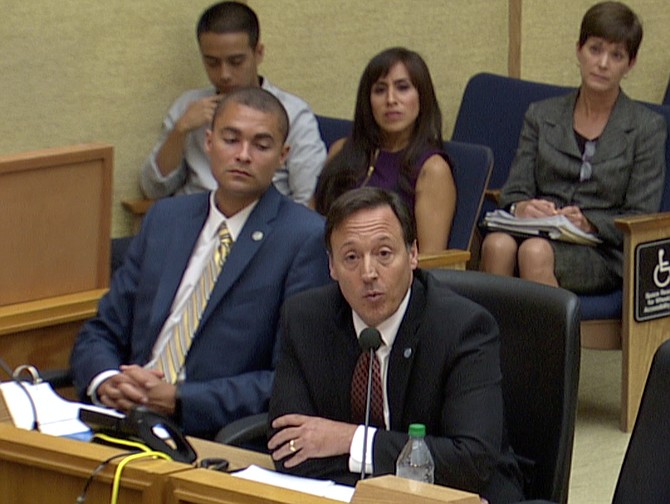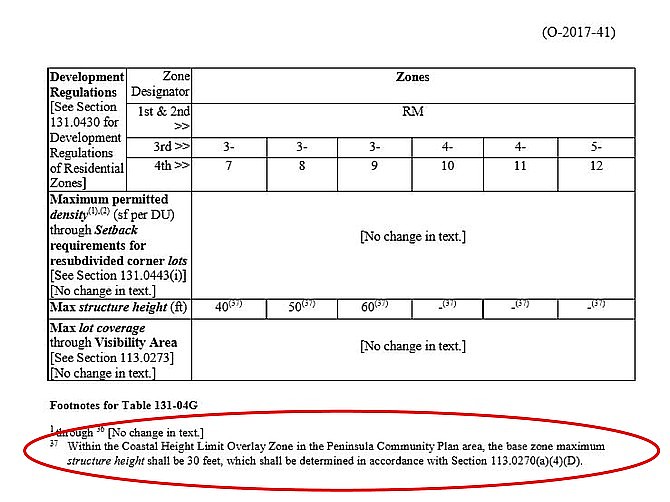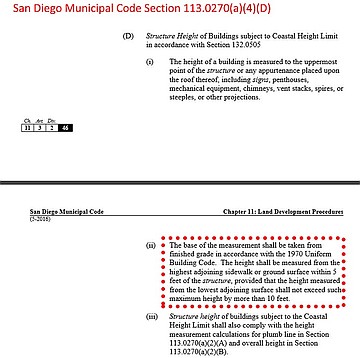 Facebook
Facebook
 X
X
 Instagram
Instagram
 TikTok
TikTok
 Youtube
Youtube

On November 15, three Point Loma residents contacted me after the city council voted on a proposed municipal code change. The change is in the form of a footnote touted as closing an alleged loophole that has allowed developers to exceed the 30-foot coastal overlay height limit — in direct opposition to the will of the voters who instituted 1972’s Proposition D. One resident said, "I think we've been had."
Geoff Page, former chair of the Peninsula community planning board, was far more emphatic. In fact, Page sent a letter protesting the change to the planning commission in September and the city council in October and November, before each heard the issue.

“The real purpose for the proposed change is to let the Development Services Department off the hook for projects it incorrectly approved that exceeded 30 feet,” said Page. “The footnote merely points to the existing municipal code section that says properties within the area of Proposition D must not exceed the coastal height limit....
“The footnote makes it look like there is a new requirement, but it’s not saying anything that isn’t already there currently. Development services convinced everyone that the code was deficient when in fact the problem was that they incorrectly read the code.”

Page isn’t alone in his views: a current planning-group member said in September that the proposed amendment could have the result of validating the approach that was used on the Emerson and Evergreen project.
The Development Services Department took the time to answer a few questions via email. Page was then given a chance to respond.
How will the proposed footnote change the current process? Development Services responded, “The footnote changes the base zone height to 30 feet in certain areas, thereby requiring the stricter base zone height calculation.”
Page countered, “Nothing in the measurement section was changed — that is the key to this charade. The footnote changed nothing in the actual measurement section and only refers to existing code.”
Will the proposed new language do anything beyond referring developers to the measurement section? Development Services responded, “It reduces zoning height to 30 feet in specified zones that are within the coastal height limit overlay zone and the Peninsula community plan area.”
Page countered, “Again, the footnote doesn’t change the code, it simply refers to another already existing section.”
Was the impetus for this change to avoid litigation or to quell public uproar? Developmental Services responded, “No. The city made a change in the base zone height limit in response to community concerns about coastal height limit.”
Page countered, “Community concerns were the public uproar.”
Will Development Services continue to approve projects allowing builders to measure from a higher manufactured grade until the ordinance is officially certified? Development Services responded, “Yes.”
Will there possibly be more buildings permitted that exceed the 30-foot height limit in the coastal overlay zone? Development services responded, “We cannot speculate on this.”
Page countered, “Development Services director Robert Vacchi mentioned looking at a half dozen projects at the October hearing. They could provide this information.”
I asked District 2 councilmember Lorie Zapf’s office to comment on her understanding of the change she voted on. Her office forwarded the question to Mayor Faulconer’s office. I asked the same question of other councilmembers and was consistently referred back to Zapf.

Councilmember David Alvarez was the only councilmember to vote against the ordinance in October and in favor on November 15. Before that "yes" vote, Alvarez said that Vacchi had met with him and clarified things. Alvarez didn't respond to a request to explain what Vacchi clarified.
The next stop for the municipal code change is the San Diego Regional Airport Authority and then the California Coastal Commission, each having jurisdictions for different areas in Point Loma.
Kyle Rodenbo from councilmember Mark Kersey’s office (Kersey is an airport authority member) said that this matter normally would have gone to the authority’s land-use commission before going to the city council, but was backward this time. According to him, it’s been submitted to authority staff and likely won’t go to the land-use commission. If it does, it will be within the next couple months. He said it’s just a formality, as there are no concerns of it not being certified.
Noaki Schwartz from the state coastal commission said a few factors will determine when they will see it. One being that the city is limited to three major amendments per calendar year — meaning the change may have to wait to be batched with other submittals.
If the commission changes the proposed language, it would go back to the city council to accept verbatim. If the city doesn’t accept the commission’s changes, the whole process would start over again.


On November 15, three Point Loma residents contacted me after the city council voted on a proposed municipal code change. The change is in the form of a footnote touted as closing an alleged loophole that has allowed developers to exceed the 30-foot coastal overlay height limit — in direct opposition to the will of the voters who instituted 1972’s Proposition D. One resident said, "I think we've been had."
Geoff Page, former chair of the Peninsula community planning board, was far more emphatic. In fact, Page sent a letter protesting the change to the planning commission in September and the city council in October and November, before each heard the issue.

“The real purpose for the proposed change is to let the Development Services Department off the hook for projects it incorrectly approved that exceeded 30 feet,” said Page. “The footnote merely points to the existing municipal code section that says properties within the area of Proposition D must not exceed the coastal height limit....
“The footnote makes it look like there is a new requirement, but it’s not saying anything that isn’t already there currently. Development services convinced everyone that the code was deficient when in fact the problem was that they incorrectly read the code.”

Page isn’t alone in his views: a current planning-group member said in September that the proposed amendment could have the result of validating the approach that was used on the Emerson and Evergreen project.
The Development Services Department took the time to answer a few questions via email. Page was then given a chance to respond.
How will the proposed footnote change the current process? Development Services responded, “The footnote changes the base zone height to 30 feet in certain areas, thereby requiring the stricter base zone height calculation.”
Page countered, “Nothing in the measurement section was changed — that is the key to this charade. The footnote changed nothing in the actual measurement section and only refers to existing code.”
Will the proposed new language do anything beyond referring developers to the measurement section? Development Services responded, “It reduces zoning height to 30 feet in specified zones that are within the coastal height limit overlay zone and the Peninsula community plan area.”
Page countered, “Again, the footnote doesn’t change the code, it simply refers to another already existing section.”
Was the impetus for this change to avoid litigation or to quell public uproar? Developmental Services responded, “No. The city made a change in the base zone height limit in response to community concerns about coastal height limit.”
Page countered, “Community concerns were the public uproar.”
Will Development Services continue to approve projects allowing builders to measure from a higher manufactured grade until the ordinance is officially certified? Development Services responded, “Yes.”
Will there possibly be more buildings permitted that exceed the 30-foot height limit in the coastal overlay zone? Development services responded, “We cannot speculate on this.”
Page countered, “Development Services director Robert Vacchi mentioned looking at a half dozen projects at the October hearing. They could provide this information.”
I asked District 2 councilmember Lorie Zapf’s office to comment on her understanding of the change she voted on. Her office forwarded the question to Mayor Faulconer’s office. I asked the same question of other councilmembers and was consistently referred back to Zapf.

Councilmember David Alvarez was the only councilmember to vote against the ordinance in October and in favor on November 15. Before that "yes" vote, Alvarez said that Vacchi had met with him and clarified things. Alvarez didn't respond to a request to explain what Vacchi clarified.
The next stop for the municipal code change is the San Diego Regional Airport Authority and then the California Coastal Commission, each having jurisdictions for different areas in Point Loma.
Kyle Rodenbo from councilmember Mark Kersey’s office (Kersey is an airport authority member) said that this matter normally would have gone to the authority’s land-use commission before going to the city council, but was backward this time. According to him, it’s been submitted to authority staff and likely won’t go to the land-use commission. If it does, it will be within the next couple months. He said it’s just a formality, as there are no concerns of it not being certified.
Noaki Schwartz from the state coastal commission said a few factors will determine when they will see it. One being that the city is limited to three major amendments per calendar year — meaning the change may have to wait to be batched with other submittals.
If the commission changes the proposed language, it would go back to the city council to accept verbatim. If the city doesn’t accept the commission’s changes, the whole process would start over again.
Comments